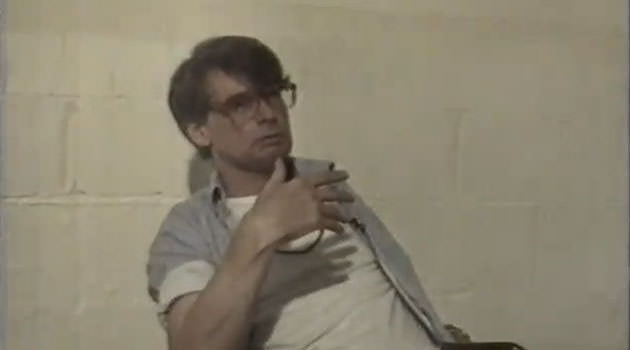On March 2, 1963, at around 11:00 p.m., as a certain 18-year-old (by some accounts 17-year-old) teenager walked down the street, a car pulled out of a driveway and stopped a block ahead of her. A man emerged from the car and started walking towards her. She wanted to pass him by, but he grabbed her with one hand while the other hand covered her mouth firmly preventing her from making any noise whatsoever. He pushed her into the backseat of the car, forced her to the floor of the car after binding her hands behind her and her ankles together, and drove away into the desert from Phoenix. The girl kept pleading with her kidnapper to let her go. All she got in return were assurances that he would not hurt her until they reached his chosen place, where he raped her and took the money she had on her — a total of four dollars — after which he drove the girl back to Phoenix, dropper her half a mile from her residence and drove away.
Shortly after the assault, the girl was interviewed by the police after she was taken to a local hospital by her family. The doctors confirmed the presence was semen inside her but rejected the girl’s claim that she had been a virgin before the sexual violation at the hands of her attacker, whom she described as a 27 or 28-year-old, little under six feet tall Mexican man with a mustache weighing around 175 pounds. She also told that he was of slender build, had short, curly hair, and was dressed in denim jeans and white shirt and was wearing dark-rimmed glasses at the time of the attack.
There were many glaring inconsistencies in what the girl had told the police. She emphatically denied that the attacker did not have an accent, but when pressed to remember, she said he could be an Italian but she wasn’t sure although she insisted that she could recognize the attacker if he was brought before her. Furthermore, her description of the events following her kidnapping did not inspire much confidence either. She gave conflicting account of whether she had removed her clothes or the kidnapper did. She also claimed to have fought her attacker back, but there were no bruises or any other visible sign of such a struggle on her body. She was unclear about how many times she had been penetrated. Her answers were evasive, her unwillingness to talk and contradictory accounts of rape led the investigators suspect that she was lying at least in part. She was put through the polygraph test, which remained inconclusive although some of her answers were found absolutely untruthful by the examiner conducting the test.
The girl also failed to give any significant details about the car her attacker had used except that it was either a Ford or a Chevy, it was green in colour with a loop of rope attached to the rear of the front seat for the passengers to hold on to while exiting the car, and that the insides of the car smelled of paint or turpentine. Due to the serious, inexplicable inconsistencies in the girl’s story combined with the improbability of the attacker’s taking the route that the girl said he took to travel out of Phoenix, the investigators were inclined to file the case away as another false report. But things changed when the family of the girl came up with a few other things that led the investigators to probe the case seriously. The family of the girl told the investigators that she was emotionally deficient in certain respects and had the general intelligence of a 12-year-old and was also extremely shy, which, to some extent, explained some of the inconsistencies in her narration of the event and also her reluctance to talk.
The most significant piece of information was supplied by the brother-in-law of the girl, who told the police that while he was picking the girl up from the bus stop due to her fear of walking down home alone, he came across a green Packard in the Marlette Street, and the girl said that it looked like the car her attacker drove on the day of the assault. He had noted the number on the license plate of the car, which he gave to the police. The investigators found that the green Packard with that number belonged to a woman in Phoenix, but when the police went to her place of residence, they found that she and her mustachioed Mexican boyfriend left the place two days back and the neighbours did not know where they had moved to. However, the postal services came in handy and with their assistance the police could manage get hold of the woman’s new address.
The green Packard was found parked in the driveway and when one of the officers peeped into the car, he did not fail to notice a rope strap attached to the rear of the front seat, like the girl had described. A few things were beginning to check out with the statement of the girl — the green car and the rope attached to the front seat of the car.
Officers Carroll Cooley and Wilfred Young were greeted at the door by Ernest (Ernesto) Miranda’s partner and common-law wife Twila Hoffman, who was the official owner of the car in question. She was 29 and had two children — a girl by Miranda and a boy by another man. Miranda had got back from work after a 12-hour shift an hour or so ago and was asleep. Twila woke him up and he greeted the officers rather pleasantly, given the circumstances. Officer Cooley asked Miranda to accompany them to the police station for questioning in connection with rape and robbery of a teenager. The officers wanted to interrogate him in a formal and unfamiliar environment to extract as much as they possibly could.
Ernesto Miranda was no alien to criminal justice system. He had been in conflict with the law since his childhood days with his first conviction took place when he was in 8th grade in Mesa, Arizona, and the very next year he was once again arrested and eventually convicted of burglary, for which he served a year in reform school. Miranda’s mother had already expired when he was convicted of his first crime and his father had married. He never warmed up to his brothers or step-mother and always kept his distance from them.
Then, in 1956, just a month after his release from the Arizona State Industrial School for Boys, Ernesto barged into an unlocked house when he caught the glimpse of a nude woman in bed, and got into bed with her but failed to have an intercourse though he stayed in bed with the woman until her husband returned and called the police to hand Ernesto over resulting in another year in the reform school for Ernesto.
After his release from the reform school, Ernesto left for Los Angeles, but a change of place did not change him and he was arrested on the suspicion of armed robbery within months of his arrival in Los Angeles, but the charges were not pressed against him and the authorities thought it better to get rid of him by deporting 18-year-old Ernesto back to Arizona.
With a criminal record that was already quite lengthy for an 18-year-old combined with complete lack of professional skills of any kind, the only thing that Ernesto could do was join the army. But that changed nothing, and his service record is replete with AWOL and voyeurism charges. Ernesto had to do six months of hard labour as punishment in the Fort Campbell, Kentucky, and after 15 months in the service, all he earned was a dishonourable discharge. At one point of time during his stint with the army he was also ordered to consult a psychiatrist.
For a few months he went around loitering from here and there, and was arrested in Texas on charges of vagrancy and then again in Nashville when he was found driving a stolen car, which landed him a year and day in the federal prison system, as he had crossed over into another state in the stolen car. He served time in Chillicothe, Ohio and then in Lompoc, California.
For the next few years Ernesto kept it down and did not do anything that would get him trouble. He kept doing menial jobs for a living, and finally managed to find employment as a laborer on the night loading dock for the Phoenix produce company, and was considered the best worker at the firm by the foremen supervising his work. It is during this time that he raped and robbed this teenager, and the police could find their way him through the green Packard.
As soon as Ernesto was in the police car with Cooley and Young, he knew that the equation had changed and inquired as to what it was about, to which the officers responded by telling him that they could not tell him anything until they reached the police station and that he was under arrest and did not have the choice of not accompanying them.
At the police station, the officers immediately arranged for an identification parade, and placed Ernesto with three Mexican-American in a line-up for the teenager victim to pick her attacker from through a two-way mirror. She could not. But Ernesto had no way of knowing that.
The officers sat Ernesto down in Interrogation Room 2 and started questioning, but at no point of time was it pointed out to Ernesto Miranda that he had the right to incriminate himself and had the right to consult a lawyer. Cooley would later testify to that effect. At the testimony Cooley said that they believed Miranda was familiar with his Constitutional rights and did not have to be told, as he was a former convict and had been through it all before.
Under intense interrogation, it did not take long for Ernesto to confess to having raped and robbed the teenager. The officers denied throughout that they had forced the conviction out of Miranda, and also denied Ernesto’s claim that the officers had told him that if confessed to the rape they would drop the robbery charge. He also said that the officers had assured him that they would get him psychiatric counseling for sexual deviance that he was suffering from.
Originally written for and published in LAWYERS UPDATE as part of a two-part CRIME FILE in September 2015.





